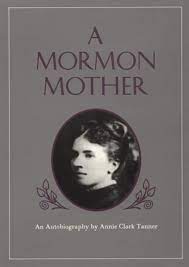Articles/Essays – Volume 06, No. 2
A Mormon Mother | Annie Clark Tanner, A Mormon Mother: An Autobiography
A Mormon Mother, which Annie Clark Tanner wrote in long hand in 1941 in her 77th year, seems especially valuable to me as an honest, perceptive account of the human problems of living polygamy during the peaceful 1870s period as well as the more tumultous era of the underground and Manifesto. She tells her story with remarkable detail drawn from her own memory, her diary, letters to and from her children and husband, and newspaper accounts. As her son Obert C. Tanner says in the foreword to the second printing in 1969, she “tells it like it was.”
Born in 1864 to Ezra Clark, a successful community leader whom she loved dearly, and his second wife, Susan, a meticulous housekeeper and able homemaker, she grew up with a positive attitude toward polygamy. The wives she knew were proud and honored to be chosen to share in the highest exaltation in the Kingdom of God. A common saying was “I’d rather have his little finger than the whole of a man outside the Church.”
In contrast to her childhood experience, her marriage in 1884 as the second wife to a prominent educator, Joseph Marion Tanner, was extremely difficult. No longer was polygamy the inviolate “capstone of Mormon doctrine.” The enforcement of the Edmunds-Tucker Act created unsettled conditions. Homes were broken up and families scattered among friends and relatives. Annie became a wife in the underground, living in borrowed rooms, and hungering to make a home for her children. Her struggles after the Manifesto were no less difficult; her own pain provoked her to re-examine her idealized childhood views.
She began to analyze her own mother’s position as a second wife and to remember some negative details. Ezra Clark married his second wife, a beautiful girl of 24, years after the first wife, Aunt Mary, with whom he had lived in Nauvoo, crossed the plains, and raised a large family. The father spent most of his time in Aunt Mary’s more spacious home, the center of activity. There the provisions were kept and frugally distributed. Company and dignitaries were entertained there. The family carriage always loaded there with Aunt Mary in the front seat and Annie’s mother in the back. When her father and Aunt Mary celebrated their 50th wedding anniversary, Annie’s mother stood quietly in the background. In recounting a dream she had shortly before her death Annie’s mother said she went to Heaven and met her husband and “Though I looked everywhere, I couldn’t find Aunt Mary.”
Aloneness is a major theme of the book. Annie was alone on her wedding night. Her husband is never mentioned at the births of any of her ten children. She established her homes alone and largely supported her children even before she and her husband officially separated. She never had the partnership we feel marriage should be today. But there are advantages to aloneness. “The wife in polygamy does not feel the security that I imagine monogamous women feel,” she writes. Yet, because of her lone position she developed an “independence that women in monogamy never know. . . . The plural wife, in time, becomes conscious of her own power to make decisions.”
In her middle years, Mrs. Tanner could no longer accept her former belief that it was man’s place to create conditions and woman’s place to accept them — his right to command and her duty to obey. The results of unquestioningly following her husband’s will were disastrous for her and the development of her family. She was forced to rely more and more on her own judgment and less on outside authority. The reader experiences her evolution from a woman directed and dictated to by forces outside herself to forces within herself.
When the Church changed its position on polygamy in 1890, many of the Saints could not forsake the cornerstone principle of their lives for which they had made such sacrifices. The ambiguous language of the Manifesto left many Saints feeling that polygamy remained a divine Commandment. J. M. Tanner was one. Because he later married three other women (a total of six), he lost his standing in the Church and eventually died alone on a unsuccessful farm in Canada. He seems to have been a villain, but we never hear his side of the story. He becomes a tragic casualty of the transition to monogamy.
A Mormon Mother is an articulate minority report of a difficult era. Mrs. Tanner illuminates dark issues that many of us don’t want to see. We prefer to view polygamy as idyllic or at least tolerable, as she did when a child, not as the painful, solitary life she experienced as an adult. For many polygamy was not a nightmare; for Mrs. Tanner it was. A Mormon Mother is a unique addition to understanding our Mormon heritage.
A Mormon Mother, An Autobiography. By Annie Clark Tanner. Salt Lake City, The University of Utah Press, 1969. 294 pp.


 Back to full Issue
Back to full Issue

